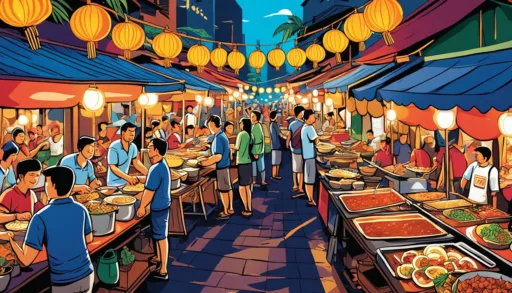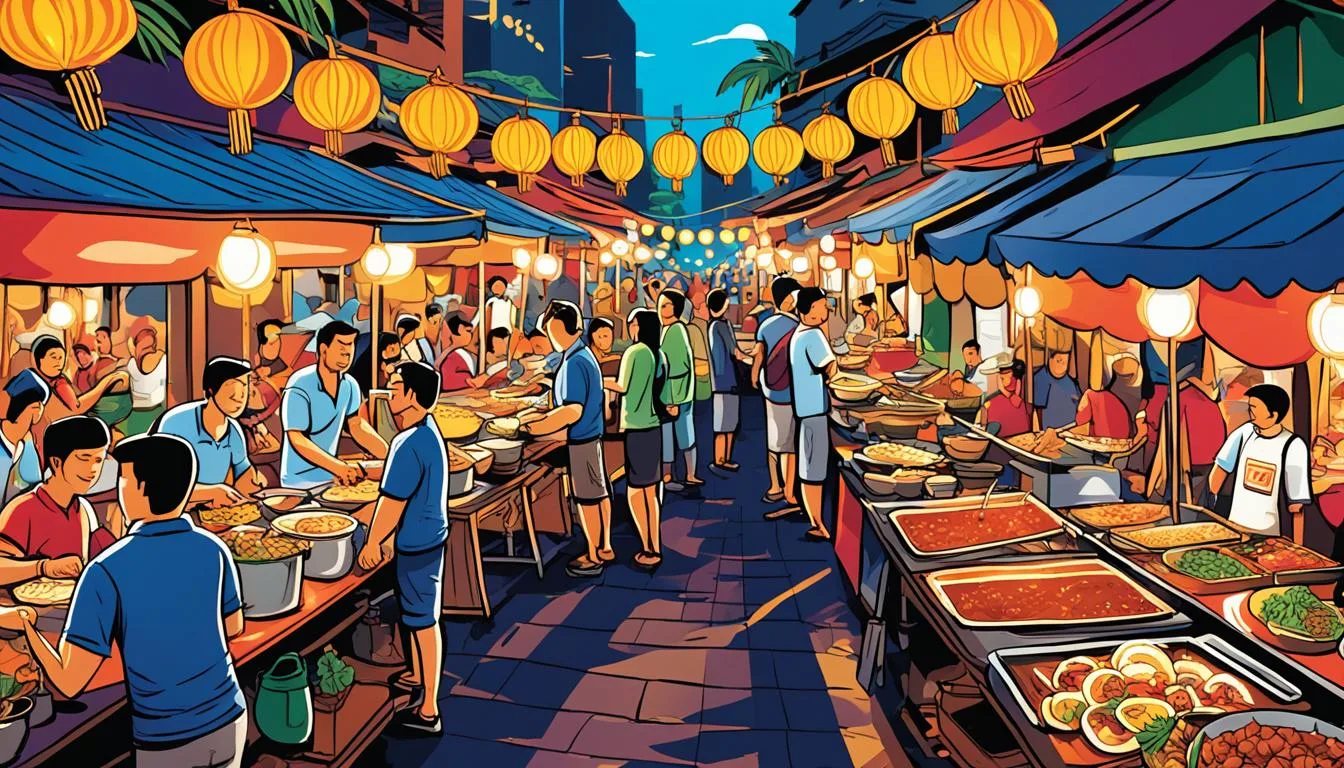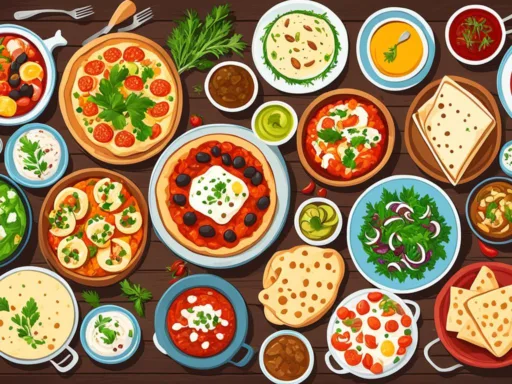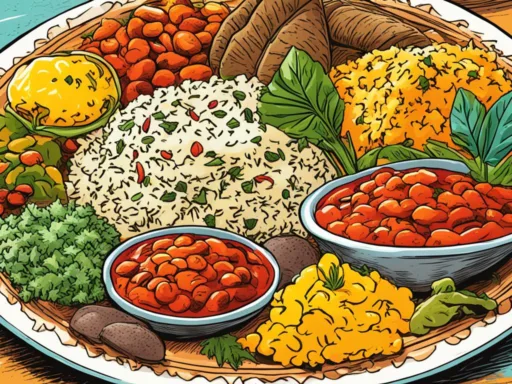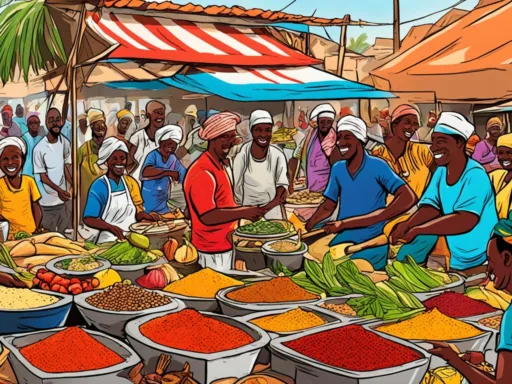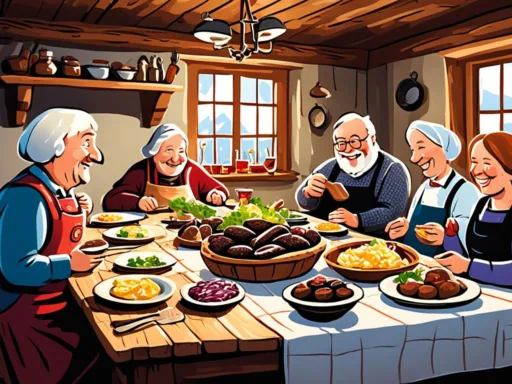Malaysia is not just a melange of captivating landscapes and vibrant cities; it’s a pulsating hub of gastronomic wizardry. If you’re on a culinary journey to uncover the secrets of the East, the rich cuisine of Malaysia, with its tapestry of flavors, is an essential stop. Could your next favorite dish be waiting in the fragrant stalls and heritage eateries of George Town in Penang? Let this Malaysian Food Guide be your compass.
Discovering diverse dishes that tell tales of cultural amalgamation is just a bite away. Embrace the epicurean delights that Malaysia offers, from the spicy, coconut-rich broths to the piquant stir-fries; every platter is a chapter from its storied past. Ascend Penang Hill, not just for its panoramic vistas but to trace the footsteps of those who forged this culinary paradise.
Key Takeaways
- Explore the United Nations of flavors with the rich cuisine of Malaysia, combining Chinese, Malay, and Indian heritage.
- Use this Malaysian Food Guide to navigate through a labyrinth of delectable local dishes.
- Experience George Town, the gastronomic heart of Penang, and its array of culinary offerings.
- Learn about the significance of UNESCO’s recognition on Malaysia’s continuous efforts in preserving both natural and cultural heritages.
- Understand the impact of the orang asli and the ethnic diversity of Borneo in enriching the Malaysian food landscape.
The Cultural Mosaic of Malaysian Cuisine
Much like a beautifully woven tapestry, Malaysian cuisine presents a complex pattern of culinary traditions, each thread a distinct flavor from its myriad of cultural influences. This rich gastronomical landscape is home to an array of dishes that represent the nation’s past and present, crafting a narrative that is as much about its people as it is about the food they prepare and share. The depth and breadth of the food reflect the true essence of Malaysia’s cultural mosaic.
The Melting Pot of Malay, Chinese, and Indian Influences
Malaysian cuisine is deeply influenced by a history of trade routes and colonial rule, resulting in a fusion where Malay influences, Chinese cuisine, and Indian flavors blend harmoniously. Staples such as the fragrant coconut milk-infused rice of Nasi Lemak and the complex spices of Indian curry dovetail with Chinese stir-fries, creating dishes emblematic of Malaysia’s plural society.
Significance of Orang Asli and Borneo’s Ethnic Diversity
The indigenous Orang Asli traditions and the Borneo ethnic diversity add another dimension to the Malaysian food mosaic. These communities contribute ancient recipes and methods, from foraged herbs to river fish delicacies, that provide a glimpse into Malaysia’s natural bounty. It is in these flavors that one can taste the true spirit of the land.
- Nasi Kandar: Showcasing the harmony of spices across cultures
- Ikan Bakar: Grilled fish that embodies simplicity and freshness
- Tuak: A fermented rice wine tying ritual to celebration in Borneo
Every meal in Malaysia thus becomes a delicious voyage through the country’s soul, offering a culinary experience where every bite tells a story of convergence and community. The significance of this diversity is not only tasted in the food but also seen in the vibrant food markets and community gatherings that are a testament to Malaysia’s social fabric.
A Gastronomic Adventure Through Penang Island
Embarking on a gastronomic adventure through Penang Island, enthusiasts of vibrant flavors and Malaysian recipe ideas will discover a treasure trove of culinary delights that paint a delicious picture of the island’s diverse heritage. In the heart of Penang, alongside the historical tapestry of Harmony Street, the food scene thrives, offering a mosaic of tastes that tell the story of Malaysia’s rich past and its innovative future.

Where tradition meets modernity, Penang’s streets transform into bustling avenues of taste exploration. The blend of cultures has birthed a myriad of dishes that resonate with the soul of Malaysian cuisine; from the aromatic complexity of nasi kandar to the tangy zest of Penang Laksa, each recipe is a celebration of multicultural symphony. Exploring the local variation of Hokkien Mee, a visitor steps into a narrative woven with noodles and spice, each bite a chapter of the island’s story.
Penang Island cuisine offers more than just food; it feeds the curiosity of those in search of original Malaysian recipe ideas. Here’s a glimpse into the staple dishes that define Penang’s culinary landscape:
- Nasi Kandar – a melange of fragrant rice served with an array of curries and side dishes
- Penang Laksa – a sour and spicy noodle soup enriched with fish and tamarind
- Hokkien Mee – a local favorite featuring a hearty prawn-based broth and a mix of noodles
There’s also an explosion of innovation around every corner where modern cafes around pre-war Sino-Portuguese shophouses brew up creative hipster vibes alongside robust local coffees.
| Dish | Main Ingredients | Flavor Profile | Origin Influence |
|---|---|---|---|
| Nasi Kandar | Rice, curry, chicken, seafood, vegetables | Spicy, savory | Indian-Muslim |
| Penang Laksa | Rice noodles, mackerel, lemongrass, chilli | Tangy, spicy, sour | Malay-Chinese |
| Hokkien Mee | Egg noodles, rice noodles, prawn broth, eggs, pork | Savory, deep-flavored | Chinese |
For those seeking to push the boundaries of their palate, a visit to Penang Island is more than just a stopover; it’s a leap into a realm where the gastronomic adventure never ends. Every street, every stall, every lingering aroma adds a piece to the majestic puzzle of Malaysian gastronomy.
Malaysian Food Guide: A Comprehensive Tour
Embark on a journey through the vibrant and multi-layered flavors of Malaysia with our comprehensive Malaysian Food Guide. This section will introduce you to some of the most authentic Malaysian dishes, showcasing the rich tapestry of tastes that Malaysia offers, from traditional street-food delights to the nasi kandar specialty of Penang.
Nasi Kandar: The Emblem of Penang’s Culinary Richness
At the heart of Penang’s culinary universe lies nasi kandar, a dish that truly represents the island’s cultural amalgamation. Aromatic rice is accompanied by an array of curries and side dishes, creating a harmonious medley of flavors that speak to Malaysia’s complex history and culinary evolution.
For connoisseurs seeking the quintessential nasi kandar experience, a visit to the bustling eateries where this specialty is served is a must. The flavors are robust and eclectic, ranging from succulent meats to delicately spiced seafood. Here’s a look at what you can expect to find on a typical nasi kandar plate:
| Component | Description | Origin |
|---|---|---|
| Steamed Rice | Plain or mildly flavored with spices like cardamom | Malay |
| Curry Mixture | A mixture of chicken, beef, or seafood curries | Indian |
| Vegetable Side Dishes | Options like okra, eggplant, and cucumber in spicy seasoning | Malay/Indian |
| Fried Proteins | Fried chicken, squid, or prawns coated in a signature spice blend | Malay/Chinese |
Relishing Traditional Malaysian Street Food
No comprehensive Malaysian Food Guide would be complete without a deep dive into the bustling street food scene. Traditional Malaysian street food is a testament to the country’s rich culinary diversity, with each bite revealing details of its multicultural heritage.
Let’s explore some of the must-try street food items that make Malaysia a paradise for food lovers:
- Penang Laksa – a tangy and spicy noodle soup with a distinctive fish-based broth
- Satay – skewered and grilled meats with a sweet and spicy peanut sauce
- Char Kway Teow – stir-fried flat rice noodles with shrimp, bloody cockles, Chinese lap cheong (sausage), eggs, and bean sprouts
- Rojak – a fruit and vegetable salad dish tossed with a spicy palm sugar dressing
Hawker centers, like the famed New Lane Hawker Center, are culinary playgrounds where locals and tourists alike gather to savor these delights, illustrating the community’s shared passion for authentic Malaysian food.
Trace the Historical Palate of Taiping and Kuala Sepetang
Embark on a culinary exploration to appreciate the time-honored flavors that embellish the sustainable city of Taiping, a haven of eco-consciousness and home to a treasure trove of Perak State’s culinary heritage. Its serenity and rich history blend beautifully with the vibrant taste experiences awaiting the sensitive palate. An intimate encounter with Taiping’s gastronomy is not only a dining pleasure but a step back in time, where every bite tells a tale of colonial influences and local tradition, woven into the tapestry of Malaysian cuisine.
Experiencing Food in Malaysia’s Most Sustainable City
Taiping’s commitment to sustainability permeates its approach to gastronomy. The town’s title as one of the most sustainable cities is mirrored in the locally sourced ingredients and the eco-friendly practices of its bustling food venues. One such place is the Larut Matang Hawker Center, where the local community gathers to savor traditional dishes including the legendary Char Koay Teow, a testament to Taiping’s historical palate.
A Journey Through Time with Perak State’s Culinary Heritage
In the nearby coastal village of Kuala Sepetang, a rich history is married to the bounty of the sea. Here, Malay-style seafood is not just consumed but celebrated, set against the backdrop of conservation efforts like the enchanting mangrove forest park. Such ecotourism initiatives highlight the integral role of environmental stewardship in preserving the area’s natural offerings, of which its culinary delights are intrinsically a part.

Ipoh’s Culinary Scene: More Than Just White Coffee
The thriving Ipoh culinary scene extends far beyond the famed white coffee origin to offer a fascinating array of Old Town culinary delights and traditional Malaysian food. A stroll through the historic lanes can lead to a sensory journey filled with rich aromas and time-honored recipes.

Discovering Old Town Ipoh’s Culinary Delights
Ideally nestled in the nostalgic streets of Ipoh’s Old Town, food enthusiasts can indulge in a myriad of tastes shaped by the area’s storied past. From bustling hawker centers to quaint cafes housed in pre-war buildings, every corner presents a new discovery.
- Bean Sprout Chicken – Juicy poultry paired with plump, crisp bean sprouts and doused in soy-based sauce
- Ipoh Hor Fun – Silky flat rice noodles swimming in a savory broth
- Tau Fu Fah – Soft and silky beancurd dessert, characteristically served with a clear syrup
Unraveling the Tales Behind Traditional Dishes
The history-rich city of Ipoh permeates through its traditional dishes, much like the stories within the walls of the Han Chin Pet Soo Hakka museum. Visiting this historical site presents a dual narrative of the tin-mining era and its indelible impact on local flavors.
- Mushroom Chee Cheong Fun – Delicate rice noodle rolls filled with earthy mushrooms, a tribute to Ipoh’s multicultural canvas.
- Pomelo Salad – A refreshing dish featuring the local fruit, symbolizes the zest and diversity of Perak’s cuisine.
- White Coffee – A legacy brew that epitomizes the city’s innovation within a cup of aromatic bliss.
Ipoh’s culinary tale is as profound as its limestone caves, offering a perfect blend of historical charm and gastronomic excellence—redefining what traditional Malaysian food is all about.
Kuala Lumpur’s Epicurean Escapade
Embark on an Kuala Lumpur epicurean escapade that takes your taste buds on an exhilarating tour through some of the top Malaysian restaurants. This vibrant city is a melting pot of gastronomic delights, harmonizing the traditional flavors at the base of modern marvels with the bustling alleys of historic quarters. For food enthusiasts and curious travelers alike, Kuala Lumpur presents a tapestry of dining experiences that weave together the rich narrative of Malaysia’s culinary evolution.
The heart of Kuala Lumpur pulsates with a diverse range of dining establishments, from age-old hawker stalls in Chinatown serving comfort foods that have stood the test of time, to chic cafes and upscale restaurants that underscore the city’s rapidly growing food scene. Whether you are craving a taste of the time-honored street food or yearning for the avant-garde cuisine that heralds the future of Malaysian gastronomy, you will find your cravings sated here.
- Immerse yourself in a vibrant mix of traditional and contemporary culinary styles
- Explore the historical Chinatown district, known for its robust street food scene
- Indulge in luxurious dining experiences at the foot of architectural wonders like Merdeka 118
- Uncover the hidden gems of Kwai Chai Hong Alley with its array of boutique eateries and bars
| Culinary Experience | Location | Highlights |
|---|---|---|
| Chinatown Street Food | Historical Chinatown District | Authentic local dishes, vibrant night market, traditional desserts |
| Merdeka 118 Eateries | Base of Merdeka 118 Tower | Luxurious ambience, panoramic city views, diverse international cuisines |
| Kwai Chai Hong Cafes & Bars | Kwai Chai Hong Alley | Chic urban spots, craft cocktails, creative Malaysian fusion |
From the mystical allure of the Batu Caves to the serene ambiance of heritage sites, every meal in Kuala Lumpur is an opportunity to indulge in a chapter of the city’s dynamic story. This is more than just a place to eat; it’s a destination where culinary heritage and modernity thrive side by side, offering a spectrum of flavors that epitomize Malaysia’s unique food panorama.
The Best Malaysian Food Immersion in Sarawak
Embark on a culinary odyssey to Sarawak, and you will indulge in a unique Sarawak immersion that perfectly marries the state’s lush natural landscape with its rich tapestry of flavors. Sarawak, teeming with rainforests and traditional longhouses, is a haven for food enthusiasts seeking to experience the best Malaysian food through a lens of authenticity and diversity.
As the melody of the sapeh, a traditional lute, fills the air, one is drawn deeper into the heartland of Sarawak, where the indigenous Dayak communities serve as both the keepers of the land and the purveyors of an authentic Dayak cuisine experience like no other.
Authentic Dayak Cuisine: A Taste of Indigenous Borneo
If your palate seeks adventure, look no further than the dishes provided by establishments such as Lepau. These restaurants leverage homegrown ingredients and time-honored techniques to bring diners closer to the roots of Borneo with every bite. With tantalizing dishes like the fragrant umai, a traditional raw fish salad, or the hearty pansuh, meat cooked in bamboo, the culinary explorations here are not just about the taste but the storied journey behind each dish.
Exploring the Unique Flavors of Sarawak Laksa
Perhaps the jewel in the crown of Sarawak’s culinary repertoire is the renowned Sarawak Laksa, a bowl brimming with unique Sarawak Laksa flavors. Distinctively different from its Peninsular cousins, this Laksa is a harmonious blend of coconut milk, tamarind, and a complex spice paste, creating a broth that is both soul-warming and palate-tingling – a true tribute to the complexity and richness of Sarawak’s heritage.
Whether you’re a seasoned globetrotter or a curious foodie, the journey through Sarawak’s gastronomy is an unforgettable voyage into Borneo’s heart and soul, where every dish is a story waiting to be savored. The cuisine of Sarawak stands as a testament to Malaysia’s gastronomic grandeur, beckoning travelers from near and far to partake in its authentic heritage.
Authentic Malaysian Dishes and Their Stories in Sandakan
Separated by seas from the Peninsular, Sandakan harbors unique culinary stories that enrich Malaysia’s diverse gastronomy. The town’s culinary scene, vibrant with the blends of Malaysian, Chinese, Indonesian, and Filipino cuisines, conclusively challenges the dominance of Kota Kinabalu when it comes to must-try Malaysian cuisine. The rising interest in authentic Malaysian dishes is a culinary adventure waiting to be discovered by both locals and food enthusiasts from across the globe.
Standing testament to this rich heritage is the Agnes Keith House, where the essence of colonial influences lingers amidst the fragrances of local spices. Here, one can delve into not just the historicity but the personas behind Sandakan’s culinary stories. The food here is not just sustenance; it conveys tales of cultural confluence, visible in spots like the iconic Kedai Roti Gold Crown, where the aroma of freshly-baked bread signposts an age-old tradition of craftsmanship and the community’s palate preferences.
From the sizzling yellow mee adorned with succulent tiger prawns to colonial-inspired noodle dishes, Sandakan’s streets are a reflection of its historical and cultural journey through taste.
Below is a table that showcases some of the standout culinary offerings that define the distinct gastronomic identity of Sandakan:
| Dish | Description | Origin Influence |
|---|---|---|
| Yellow Mee with Tiger Prawns | Stir-fried noodles with a generous helping of spices and sea-fresh tiger prawns. | Malaysian-Chinese |
| Bread and Cakes at Kedai Roti Gold Crown | A local bakery famous for its savory bread rolls and sweet cakes, echoing the sentiments of the community’s palate. | Malaysian-European |
| Colonial-Inspired Noodle Dishes | A variety of noodle dishes that incorporate both Asian and European elements, telling the historical narrative of the region. | Malaysian-European |
The culinary tapestry of Sandakan is a testament to the intricacies of Malaysian gastronomy – a must-visit for any intrepid food lover intent on witnessing the confluence of tastes, stories, and history.
The Role of Malaysian Street Food in Cultural Expression
The thrumming heart of Malaysia pulses strongest in the bustling lanes where Malaysian street food takes center stage, transforming the way people experience the nation’s cultural fabric. With every bite and sip within the perennially spirited coffee shops and street food corners, an unspoken narrative of Malaysia’s history and diversity unfolds.
Malaysian Street Food: More Than Just a Meal
Each hawker stall and mobile cart lining Malaysia’s streets paints a vibrant stroke on the canvas of national identity. The scents and flavors of dishes such as satay, nasi lemak, and Char Kuey Teow do more than entice; they tell tales of trade, migration, and innovation. These culinary offerings serve as a cultural expression, with each vendor upholding a legacy of recipes handed down through generations.
The Social Rituals Surrounding Malaysian Coffee Shops
Equally integral to Malaysian societal fabric are the beloved coffee shops, locally referred to as kopitiams. Here, the traditional meets the contemporary; where a sip of the rich, aromatic Malaysian coffee, often paired with kaya toast, is a ritual as much as a respite. These establishments are not merely watering holes but communal hotspots where people from all walks of life converge—thus shaping and fortifying social rituals that transcend mere consumption.
| Street Food | Cultural Significance | Typical Venue |
|---|---|---|
| Satay | Symbolizes inter-ethnic culinary fusion | Sidewalk skewer carts |
| Nasi Lemak | Considered the national dish, representing unity | Morning markets and mamak stalls |
| Char Kuey Teow | Reflects the stir-frying techniques from Chinese immigrants | Hawker centers and night markets |
| Roti Canai | Indicative of Indian influence on Malaysian cuisine | Mamak stalls and roadside eateries |
Thus, street food and coffee shops in Malaysia immortalize the blend of cultures, serving up not just meals but experiences that are ingrained in the country’s social and cultural tapestry. They illustrate an unwritten narrative—deliciously diverse and indisputably Malaysian.
Conclusion
As we’ve journeyed through the flavorsome realms of Malaysia, it’s clear how the dynamic interplay of Malay, Chinese, and Indian culinary traditions has cemented the global appeal of Malaysian cuisine. This vibrant synthesis has not only painted a delectable picture of diversity but also highlighted Malaysia’s prowess in creating a universally enticing food culture. By weaving together an intricate fabric of tastes and aromas, Malaysia does more than present a menu; it extends an invitation to a cultural dialogue around its richly laden tables.
Evaluating the Global Appeal of Malaysian Cuisine
Malaysia’s culinary allure reaches far beyond its borders, captivating food connoisseurs and curious palates worldwide. Its dishes tell a story of convergence, where spice-laden curries and succulent street food bites deliver an experience that resonates with people across continents. The esteem of this cuisine on the global stage lies not only in its robust flavors but also in its capacity to unite disparate traditions into a single, harmonious feast, making it a true embodiment of gastronomic globalization.
Preserving Malaysia’s Culinary Heritage for the Future
Yet, the true essence of Malaysian food lies in the threads of heritage running through each recipe and practice. Preserving culinary heritage is key, ensuring that the traditions and knowledge passed down through generations stand the test of time. As Malaysia strides into the future, drawing the world’s gaze to its inventive food scene, it holds dear the legacy of its ancestors. Emphasizing sustainability, community, and cultural respect, Malaysia is poised to keep its culinary flames burning bright, allowing future generations the joy of discovering its epicurean treasures.
